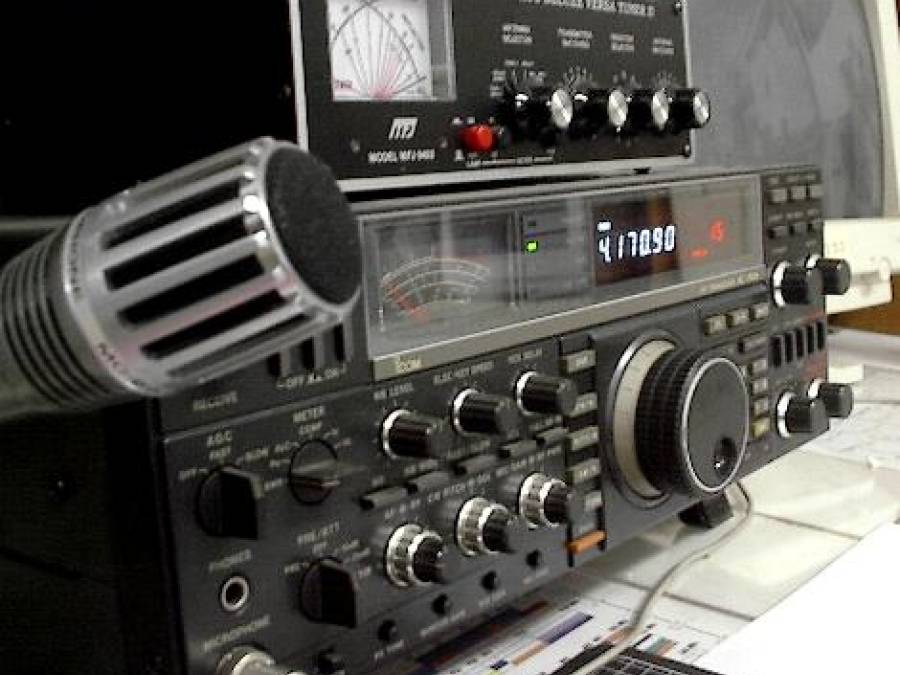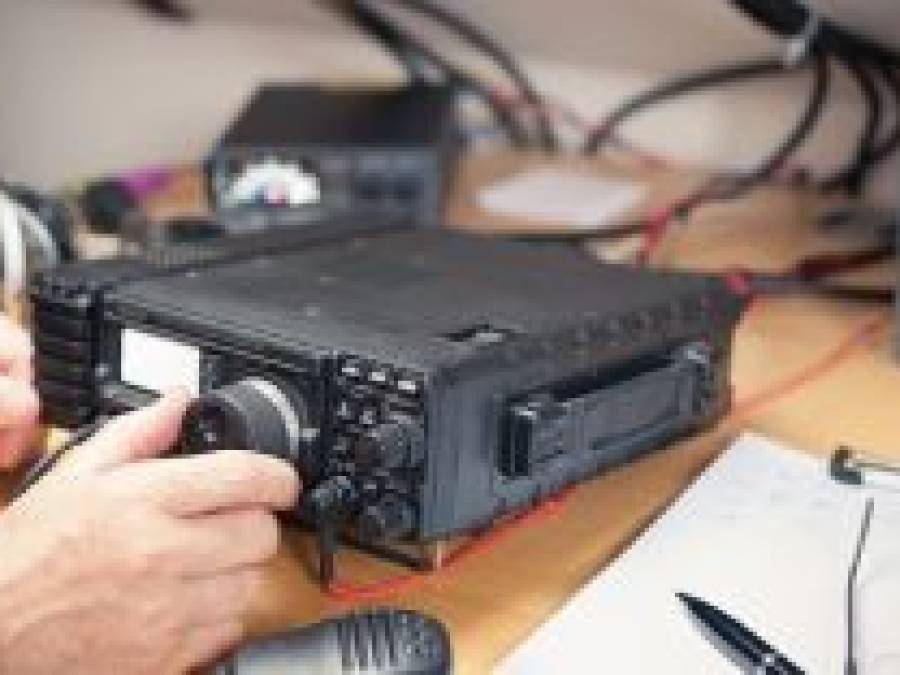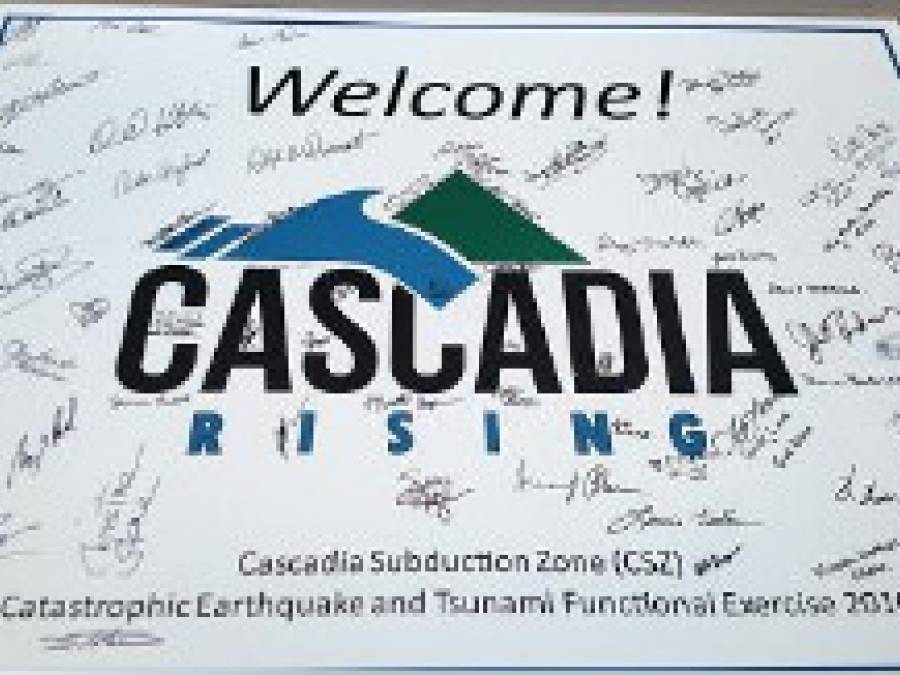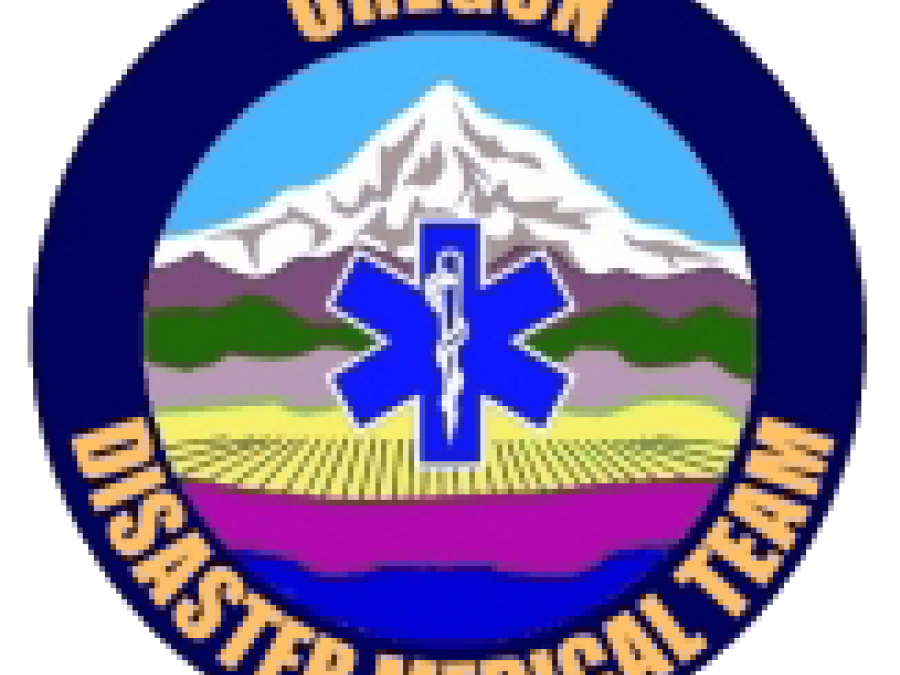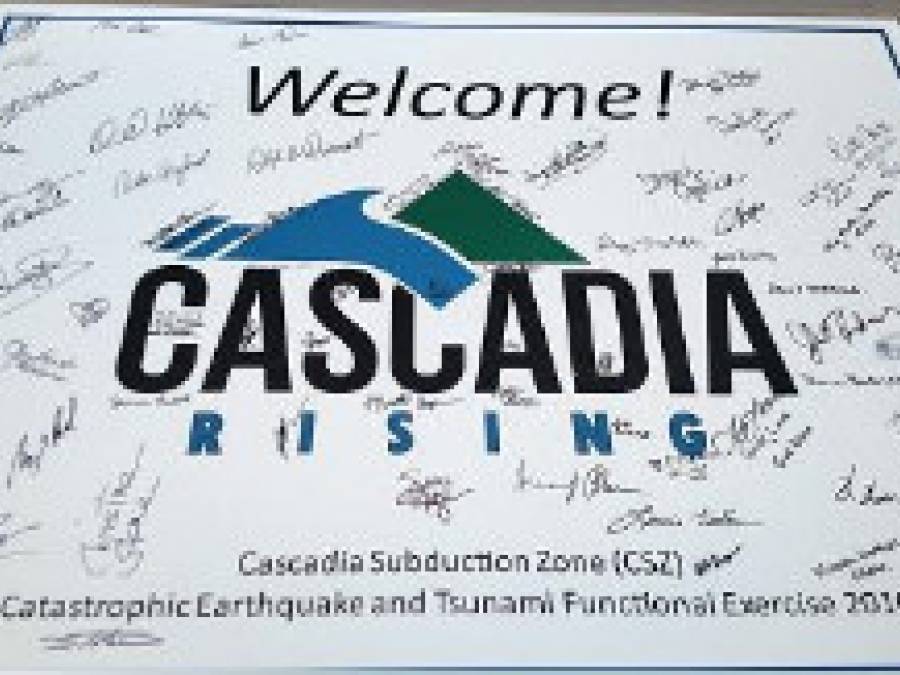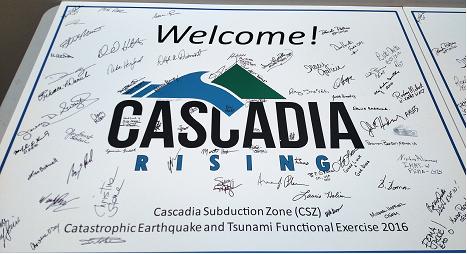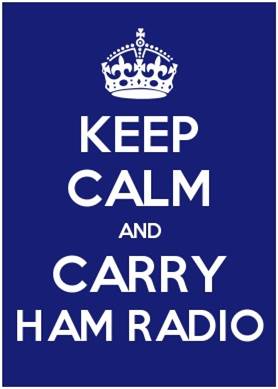This 4-day exercise tested the emergency management community’s approach to a disaster in the Cascadia Subduction Zone, using an earthquake and tsunami scenario.
John Core, KX7YT, Oregon Section Manager, and Monte Simpson, AF7PQ, Western Washington Section Manager
Recent FEMA publications tell us that science points to a large 8.0 – 9.0 magnitude Cascadia Subduction Zone (CSZ) earth-quake ripping across the 800-mile CSZ fault line on an average of once every 200 to 500 years. The fault zone follows the coastline of the Pacific Northwest states somewhere between 60 and 100 miles offshore. The last major CSZ earthquake and tsunami occurred in 1700.
When the next CSZ event happens, there will be significant loss of life and infra-structure damage. Normal means of communications, vital to response operations, will be cut throughout the Northwest. It’s then that Amateur Radio has to work and must respond. A CSZ event will be a disaster of national scale that will require many years of recovery. The major earth quakes in Japan, Indonesia, and Chile serve as a stark reminder of what is likely to happen.
The overall purpose of Cascadia Rising was to test the entire federal, tribal, state, and local emergency management com-munities’ approach to complex disaster operations, as well as their ability to work together. Concurrent with the regional Cascadia Rising activities, the Department of Defense and the National Guard bureaus of Oregon and the State of Washington were engaged in joint military response exercises using a Cascadia Subduction Zone earthquake and tsunami scenario. For operational communications groups, the purpose was to demonstrate the ability of state EOCs to establish and sustain voice and data communications with other EOCs. Operational communications were critical to success, and Amateur Radio ARES/RACES teams throughout Oregon and Washington were put to the test for the 4-day duration of the exercise.
Preparations for Cascadia Rising
Two years prior to the June 7 – 10, 2016 exercise, both Oregon and Washington ARES/RACES leadership teams began attending FEMA CR16 briefings and ramping up their membership training, co-ordination, and drills. Western Washington Section formed a coordinating group to work with Washington Emergency Management Division and began hosting quarterly EOC-to-EOC drills to sharpen their communications plans. At about that same time, Oregon ARES/RACES turned up the intensity of their semi-annual state simulated emergency tests (SETs) to stress-test both in-the-field and EOC communications. These SETs closely followed the CR16 Playbook Scenario: No repeaters, no power, no Internet in Western Oregon, and heavy reliance on Winlink HF PACTOR 3 using out-of-state gateways. Each Oregon SET involved about 300 volunteers in 25 county EOCs, plus local city EOCs, public service agencies, hospitals, and others.
The Day the Earth Shook
On June 7 at 0800, CR16 began with a simulated CSZ earthquake of 9.4 magnitude, followed by a tsunami warning.
Across Oregon and Washington, Amateur Radio ARES/RACES teams, ACS units, and NTS traffic handlers were immediately activated, connecting via HF nets on 40 and 80 meters. A team in Port Alberni, British Columbia was activated, and Amateur Radio at the Idaho Bureau of Home-land Security got on the air.
At the Oregon Office of Emergency Management (OOEM), ARES/RACES volunteers jumped into action. Forty-five Oregon stations, including net controls and relays, lit up the 80 meter SSB net and 13 county EOCs established communications with OOEM. Operators began down-loading heavy traffic on an HF Winlink PACTOR connection to Nevada, Utah, California, and Canadian gateways. This t raffic included declarations of emergency, situation reports, requests for assistance, and tactical traffic, totaling 209 messages in the first 4 hours of play. All traffic was logged on ICS 309 forms. The Winlink traffic was printed out and passed to the OOEM County Desk Liaison, who then routed it to the proper person inside the Emergency Coordination Center, which had been fully activated and staffed.
raffic included declarations of emergency, situation reports, requests for assistance, and tactical traffic, totaling 209 messages in the first 4 hours of play. All traffic was logged on ICS 309 forms. The Winlink traffic was printed out and passed to the OOEM County Desk Liaison, who then routed it to the proper person inside the Emergency Coordination Center, which had been fully activated and staffed.
At OOEM, voice messages were also being passed from FEMA Region X in Seattle on the 60 meter net, while FNARS(FEMA National Radio System) was used for FEMA keyboard chat. On SHARES (SHAred RESources High Frequency Radio Program), OOEM had contacts with Portland FBI, Idaho Department of Health Services, Oregon Health Services, the Washington State EOC at Camp Murray, and others. Most of the 80 meter ARES net activity was County EOC check-ins to establish communication links. VHF/UHF voice communications with Oregon Dept. of Transportation was also established.
The Oregon County Experience
At the county level in Oregon, ARES units were exchanging Emergency Manager inject traffic via Winlink Peer to Peer and Post Office Box systems, as well as VHF simplex and local repeaters, as some counties allowed use of emergency power-equipped repeaters. City EOCs, hospitals, fire departments, CERT teams, and others were active. In the Portland Metro Area, typical traffic was on the order of 150 messages sent/received by County EOCs over 4 days.
Elsewhere in Oregon, county units reported good success. Oregon District 2 Emergency Coordinator David Freitag, W7KFO, said that the Crook County, Oregon ARES/ RACES Team, achieved “last mile” connectivity directly to their served agency e-mail system, and further commented:
The combination of OADN (Oregon ARES Digital Network) radio equipment at the ECC, our [emergency communications van] at the EOC, and an operator inside the EOC with an e-mail account on the EOC LAN (Local Area Network) allowed the two-way exchange of error-free digital messages directly with EOC leadership personnel in Command and Planning. We used a thumb drive to create a “sneakernet” message connection between the van laptop and my COML laptop inside the EOC. We utilized a combination HF PACTOR, HF Packet, and Peer to Peer Packet protocols to move traffic between the EOC and OOEM, as well as neighboring Deschutes County.
The High Desert Amateur Radio Group (HiDARG) in Bend, Oregon, led by Ray Spreier, KG7AV, reported experiences and observations inside the St Charles Health System (SCHS) EOC:
Being in the unified EOC offered us the opportunity to make radio and continuity of communications a visible and valuable resource at the executive level. In order to facilitate the learning component, there was a lot of reliance on cell phones and internal e-mail between sites in the morning. There was an opportunity in the after-noon to walk through scenarios in which those resources simply would not be available. The SCHS executive team assembled clearly saw the implications and value in having radio as a core component in the communications planning.
In all, 22 County Emergency Managers and at least five City Emergency Managers were involved in Cascadia Rising in Oregon. Cascadia Rising 2016 underscored the importance of Amateur Radio auxiliary communications and that it worked well. We were proud to be a part of CR16.
At the National Level
At the National level on June 7, Oregon ARRL Liaison Station KX7YT began transmitting traffic by HF Winlink to W1AW, connecting to gateways in Nevada and California. The first messages began with a NOAA National Tsunami Warning Station earthquake notification and tsunami warnings. Over the course of the morning, 17 additional drill messages were sent to ARRL Emergency Preparedness Manager Mike Corey, KI1U, via W1AW. These included earthquake and tsunami situation reports, and simulated Ham Aid equipment and operator requests. Check-ins were made with the ARRL 20 meter Cascadia Net.
In the State of Washington, June 7 was also the first day of the exercise and that day was used for ARRL play and served as an opportunity for hams in counties not participating in the formal aspects of the exercise to have some involvement. The primary method of communicating between amateur stations was HF Winlink. Some of the local stations used other methods of relaying traffic, such as VHF/UHF voice nets and Fldigi.
Wednesday through Friday, June 8 – 10
These 3 days were scripted as telephone/ Internet “up” days for most counties, so the Amateur Radio operators had easier duty. FEMA Region X arrived in force at OOEM on Wednesday and as their comm vans were activated, ARES operators in the OOEM radio room began to experience RF interference on their SHARES/FNARS radios. This was scripted. FEMA then shut down 60 meters and SHARES radio operations for 2 hours to coordinate frequencies and re-engineer their radio systems. Too much RF in too small a space underscored the need for frequency coordination.
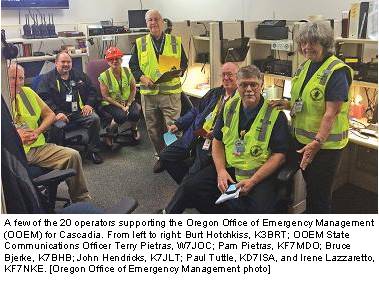 About100 Winlink messages were received at Oregon OEM from participating agencies that chose to be active on Wednesday. Again, at 0800L on Thursday morning, Winlink traffic started coming into Oregon OEM and county units began checking into the 80 meter net. Oregon ARES operators took traffic on 60 meters, SHARES, and FNARS, but the majority of the activity was again on HF Winlink PACTOR. By the end of the day on Thursday, 52 messages were received and passed to the OOEM County Desk Liaison. About five messages from the ECC were transmitted from Oregon OEM to participants. As Cascadia Rising wound down on Friday, activity dropped off.
About100 Winlink messages were received at Oregon OEM from participating agencies that chose to be active on Wednesday. Again, at 0800L on Thursday morning, Winlink traffic started coming into Oregon OEM and county units began checking into the 80 meter net. Oregon ARES operators took traffic on 60 meters, SHARES, and FNARS, but the majority of the activity was again on HF Winlink PACTOR. By the end of the day on Thursday, 52 messages were received and passed to the OOEM County Desk Liaison. About five messages from the ECC were transmitted from Oregon OEM to participants. As Cascadia Rising wound down on Friday, activity dropped off.
By 4 PM Friday afternoon, Cascadia Rising was history. We learned a lot about how critical Amateur Radio will be when a real event occurs. OOEM Director Andrew Phelps personally thanked all of the Amateur Radio operators for their service, noting that Oregon ARES/RACES was “vital to our success.”
The Washington Experience Washington’s experience during the remaining 3 days of the exercise was similar to Oregon’s. Ed Leavitt, K7EFL, RACES Radio Room Supervisor for the Washington Emergency Management Division, reported that his team was busy for the entire exercise. The Washington State Guard EMCOMM unit provided Amateur Radio operators to the EMD RACES Radio Room and was assigned to augment National Guard Joint Incident Site Communications Capability teams assigned throughout Western Washington.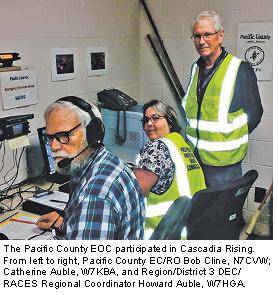
The coastal area of the State of Washington was of particular interest, as this area would be most impacted during an earthquake of the degree being exercised in Cascadia Rising 2016. It was estimated that approximately two-thirds of our communications capability would be lost in the earthquake, making Amateur Radio support vital. Pacific County EC/RO Bob Cline, N7CVW, reported that hams there were very engaged during the exercise. His team of 26 operators handled 12 voice messages and 200 data messages. The hams volunteered their services for 289.3 hours and traveled 217 miles in support of Cascadia Rising 2016.
Doyle Wenzel, N7UJK, EC/RO for Grays Harbor County, reported that30 hams there were involved with the exercise. The hams volunteered 200 hours during their 4-day participation in the exercise, and handled five voice messages and 15 data messages. Clallam County EC/RO Bill Carter, W7WEC, reported that 20 ARES/RACES volunteers worked 460 hours during 4 days to support the exercise. Following the exercise, Jaime Wisecup of the Clallam County Department of Emergency Management made the following comment to the Peninsula Daily News: “The recommendation is we need to staff more Amateur Radio operators per command areas...for exercises and real events.”
 Counties to the east of the coastal area reported great accomplishments as well. Skamania County EC Kevin Widener, KE7IN, reported that they had contact with Hood River, Oregon during their 1 day of play. The ARES/RACES team had worked with the staff of the Idaho National Guard’s Joint Incident Site Communications Capability (JISCC) team. One of the objectives of the exercise was to provide interoperability between local, state, and federal agencies. The JISCC provides flexible communications not only to the military, but also to civilian agencies needing assistance.
Counties to the east of the coastal area reported great accomplishments as well. Skamania County EC Kevin Widener, KE7IN, reported that they had contact with Hood River, Oregon during their 1 day of play. The ARES/RACES team had worked with the staff of the Idaho National Guard’s Joint Incident Site Communications Capability (JISCC) team. One of the objectives of the exercise was to provide interoperability between local, state, and federal agencies. The JISCC provides flexible communications not only to the military, but also to civilian agencies needing assistance.
Whatcom County EC Jim McCabe, AE7UQ, reported that his team’s 27 volunteers provided communications for 32 hours during the event. During an actual large-scale earthquake event, Whatcom County would be isolated from the remainder of Washington State, and for this reason they maintain contact with jurisdictions in adjacent British Columbia. In this case, they maintained contact with the Langley, British Columbia EOC.
Throughout the planning and execution phases of the exercise, two teams in the Eastern Washington Section provided outstanding support. Spokane Regional RACES Coordinator Robert Wiese, W7UWC, did an outstanding job of coordinating efforts between the west and east sides of the state. This is a critical piece for the response and recovery of the people on the west side, as the people responding and the logistics will be from the east side of the state and beyond. David Dorman, K4FRA, worked diligently with the Grant County Department of Emergency Management to support the exercise.
While preparing for Cascadia Rising 2016, Washington ARES/RACES leadership kept in close contact with their counterparts in British Columbia, who were holding their Coastal Response exercise at the same time. Especially helpful during this time was Paul Peters, VE7BZ, Cowichan Valley Regional District, and S/SGT Ron Casey, VE7VTA, who is the emergency planner for the RCMP in Surrey, British Columbia.
Special thanks to Mike Chaplin, NC7Q, and Scott Honaker, N7SS, who worked very hard to see that Cascadia Rising 2016 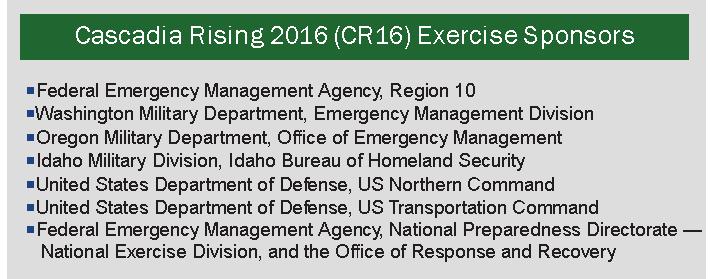 was a success. They put in hundreds of hours over the 2-year planning period working on various aspects of amateur communications, especially Winlink procedures and message formatting. Steve Aberle, WA7PTM, ASM and Assistant State RACES Officer, worked very hard with the tribal emergency managers in the state to ensure that Amateur Radio was there for them to provide communications during the exercise and beyond.
was a success. They put in hundreds of hours over the 2-year planning period working on various aspects of amateur communications, especially Winlink procedures and message formatting. Steve Aberle, WA7PTM, ASM and Assistant State RACES Officer, worked very hard with the tribal emergency managers in the state to ensure that Amateur Radio was there for them to provide communications during the exercise and beyond.
The Amateur Radio Service shined during Cascadia Rising 2016. Radio amateurs met every expectation of the premise that FCC licenses are issued at the public’s convenience, necessity, and interest.
Lessons Learned
This experience has taught us that our EOC equipment must be constantly used, re-paired, and exercised to assure that it works; that operator training using the equipment is essential, and that radio equipment improvements are needed. Specifically:
-
We have far too few trained operators, considering the strong demand for support from increasingly more governmental organizations and NGOs. This is a system-wide problem shared by our served agencies and our auxiliary communications organizations, be they ARES/RACES, RACES, ACS, CERT, hospital teams, or others. When a real CSZ event occurs, Pacific Northwest Amateur Radio organizations will need a lot of help. To be prepared, we need a major recruiting effort to bring new people into public service.
-
Both Washington and Oregon are strong Winlink system users, but are limited by PACTOR 3 technology that is just too slow to accommodate the heavy volumes of traffic we anticipate. We are hopeful that the FCC will approve the use of PACTOR 4 soon. Plans need to be made to fund up-grades to our aging PACTOR 3 modems.
-
Our use of the 60 meter band during CR16 was promising, but had several problems; much of our 8-year-old radio equipment must still be modified to accommodate 60 meters; the Amateur Radio Service in the US needs additional 60 meter frequencies for intrastate short-distance HF communications aside from interoperability with federal agencies, but the transmitter output can remain as it is on the present 60 meter channels with the same antenna restriction.
-
We need to work more often directly with our served agency Emergency Managers during drills and exercises to improve traffic flow and administrative handling.
-
With regard to antiquated equipment, there needs to be an incentive program to encourage Emergency Management Agencies to update their radio equipment.
The importance of constant and regular drills, exercises, and training cannot be over-emphasized, and it can be a lot of fun. Those of us that participated in Cascadia Rising 2016 know that we have a serious responsibility: be ready, be trained, and be confident in your ability to support our served agencies. Amateur Radio must work. Pacific Northwest amateurs may be called to serve again when a real disaster happens.
John Core, KX7YT, is currently serving as Oregon Section Manager and has been active in Oregon Section ARES/RACES for many years. Licensed in 1970, he holds an Amateur Extra class license and enjoys HF contesting, his six grandchildren and extended family.
After high school, Monte Simpson, AF7PQ, at-tended Radio-Television Broadcast Technician training. He worked briefly in radio broadcasting before pursuing a career in public safety communications. Monte has served as a dispatcher, supervisor, and manager; he will be retiring in October 2016, after 47 years of service. Monte served in the US Navy as a Radioman aboard destroyers during Vietnam and then had various assignments in the Navy Reserve. Following the Navy Reserve, he served in the Coast Guard Reserve, retiring after 36 years of service as a Chief Warrant Officer 4 (Communications).
Monte started in the Amateur Radio Service in 1992. He has served in various positions for ARRL since March 1993, including AEC, EC, DEC, A-SEC, ASM, and SM.
Other duties include OO and VE. In January 2013, Monte began serving as a volunteer for the Washington State Emergency Management Division as the State RACES Officer.
Some of Monte’s major accomplishments in communications are having the opportunity to serve as the communications officer for the Federal On Scene Coordinator for 3 weeks during the Exxon Valdez oil spill. He facilitated the US Amateur Radio participation in the 2010 Winter Olympics held in Vancouver, British Columbia, Canada. He was APCO International’s Communications Center Director of the Year for 2013. During the past 2 years, he has served as a Co-Lead for the Cascadia Rising ESF2 sub working group.
Reprinted with permission from September 2016 QST ARRL, the national association for Amateur Radio® www.arrl.org

